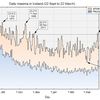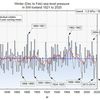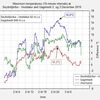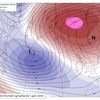30.1.2012 | 21:55
Calculating temperature averages in Iceland - part 1
This post outlines the problems of using daily maximum and minimum temperatures for the construction of long-term temperature series in Iceland. It is not a judgment on the use of the method elsewhere.
So-called fixed hour means (FHM) have been used for the calculation of mean monthly temperatures in Iceland since the Danish Meteorological Institute (DMI) took over weather observations in Iceland in 1872.
The fixed hour mean is the monthly average temperature at each of the observing times in the regular schedule at the respective station. Informally this average is also sometimes referred to as the clock mean.
In many parts of the world, the average of daily maximum and minimum temperatures (XNM) has been used for the calculation of the monthly mean temperature. In practice, there is a systematic difference between the two methods, but largely depending on location, time of the year, screen type etc. We will later look at the difference in Iceland.
There are a number of reasons for the preference of FHM rather than XNM in Iceland. We will look at a few of them:
1. The maximum and minimum thermometers are more difficult to read than other standard thermometers, as the gradation is often 0.5°C on the max and min thermometers, but 0.2°C on the others.
2. The max and min thermometers are touched and moved once or twice per day. The maximum thermometer is taken out of the screen and has to be reset by "force" (arm swing). In this process, it suffers more accidents than the fixed ones. Because of this the maximum and minimum temperature are often missing in older measurements, it took time to replace broken instruments. For this practical reason, maximum thermometers were in use at only few stations in earlier times. The minimum thermometers showed much more drift than other did, index corrections even up to 2 to 5°C were used.
3. The maximum and minimum reading practice has changed throughout time. This problem does not apply where there have been no such changes. There are at least two kinds of complications associated with changes in the reading practice.
(i)) The more serious one affected the Iceland temperature series from the 1932 to the 1950s, as the synoptic stations became more important in the network. The so-called Copenhagen observation practice (International Synoptic code of 1929) recommended that minimum temperatures were only read in the morning and the maximum only in the evening. It was also stipulated that both in the morning and the evening both thermometers should be reset and only the reset temperatures noted (for calibration purposes).
This has the consequence that if the actual highest temperature during the 24 hours really occurred during the night or the minimum during the day these were lost. In a later letter amending the codebook the observer was given free hand to note abnormal temperatures during this blank periods in the journal – but this was rarely done if at all. During a large part of the winter, the adiurnal variability (the vagaries of the weather systems) is very large in Iceland. During this time of the year many maxima and minima where thus lost. The diurnal variation is much more regular during summer and much fewer maxima or minima are lost. In lower latitudes, this problem is not as serious.
An analysis of this problem is to be found in the Hovmöller reference below. There one can read about the surprisingly large corrections that are necessary during the Copenhagen code period in Iceland.
(ii)) But why did the “Copenhagen code” introduce this problem? It was a remedy against the other reading practice effect, the problem of "double maxima" and minima. The "double maxima" are not uncommon in Iceland due to the abovementioned adiurnal variability of temperature. In the code that in 1949 replaced the Copenhagen code the maxima and minima where supposed to be read two (or four) times per day, if two times per day, then at 6 and 18 GMT. However, at six in the morning the observers must be paid at night work wages. Therefore, a compromise was made for Iceland, the maximum and minimum were there read at 9 and 18 GMT.
The 9 GMT reading has the advantage that it “caught” the real overnight minimum – in fair weather in spring and autumn it usually occurs very late in the night, after 6 GMT. By reading at 9 GMT the number of so-called double minima was largely avoided. When the minimum is read (and reset) only once per day, cold nights (night 1) smear over to a succeeding warmer night (night 2) – because the temperature at the reading time on night 1 is lower than the minimum of night 2. The Copenhagen reading practice avoided this by resetting the minimum thermometer at 18 GMT.
According to the Copenhagen practice, the maximum temperature was read and reset at 18 GMT, and a reset of the maximum thermometer at 9 GMT. In Iceland 18 GMT (17 local Icelandic time) is a bit early in the afternoon. Reading and reset time at 21 GMT should therefore be preferred. However, matter of costs also intervened. Most of the telephone (telegraph) stations in the countryside had closed by 21 GMT; they would be open only at a special cost. The 18 GMT reading was thus used at all of the synoptic stations.
When the climatic stations started to read the maximum and minimum thermometer twice per day, the reading was done at 22 GMT, which was then the traditional evening observation hour. This was changed to 21 GMT in 1961.
The practice of reading the maximum at both 9 and 18 GMT instead of 9 and 21 increased the number of “double maxima” in Iceland, i.e. when the temperature at 18 GMT on day 1 exceeds the highest maximum on the following day (day 2). The temperature at 18 on day 1 thus becomes the maximum temperature on day 2.
This also means that the average daily maximum temperature at the synoptic stations is tends to be slightly higher than the average maximum at similarly situated climatic stations.
This difficult history of maximum and minimum temperature measurements in Iceland should make it apparent why the FHM is preferred to the XNM in the construction of homogenous long-term temperature series in Iceland. However, the application of the FHM is not without problems – not at all. We will continue in the next post.
The Hovmöller (1960) report is available (in English). It is an essential read for historical climatologists, not only in Iceland, but also elsewhere.
Um bloggiđ
Iceland Weather blog
Nýjustu fćrslur
- Unusually high temperatures
- Unusually high sea level pressure
- Sea level pressure: Unusually low in Iceland this winter
- A new national maximum temperature record for December
- A new sea level pressure record for June in Iceland
- An unusually warm April in Iceland
- A new October high pressure record in Iceland
- A new absolute September maximum temperature record in Iceland
Heimsóknir
Flettingar
- Í dag (17.9.): 0
- Sl. sólarhring:
- Sl. viku: 2
- Frá upphafi: 0
Annađ
- Innlit í dag: 0
- Innlit sl. viku: 2
- Gestir í dag: 0
- IP-tölur í dag: 0
Uppfćrt á 3 mín. fresti.
Skýringar

 hoskibui
hoskibui
 svatli
svatli





Bćta viđ athugasemd [Innskráning]
Ekki er lengur hćgt ađ skrifa athugasemdir viđ fćrsluna, ţar sem tímamörk á athugasemdir eru liđin.